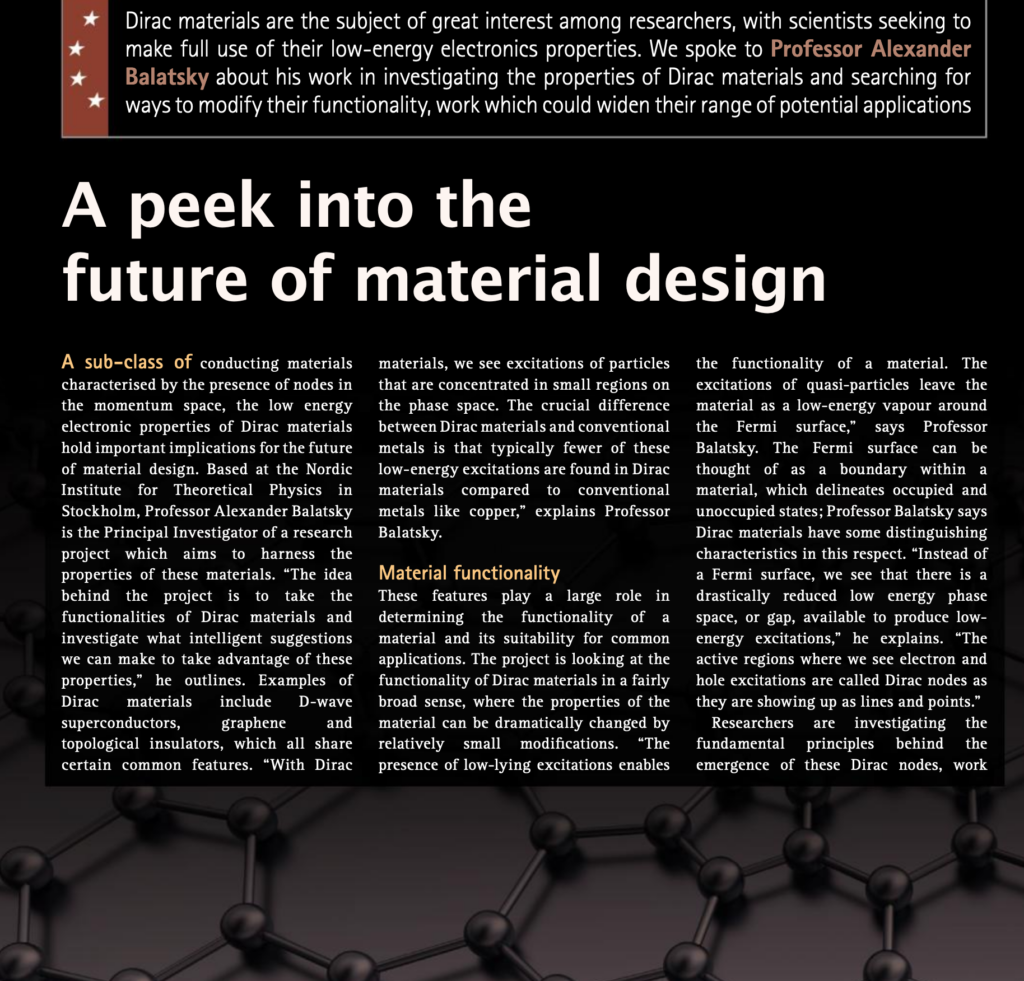


News Article
Stockholm University has published a news article about our group's work on the organic materials database, talking about the impact of AI on the search for new materials for quantum computing, electronic devices, dark matter detection and more.
VIDEO
Studies of old materials such as cellulose, or new Dirac materials like graphene, are important to create new and sustainable materials. Meet Albert Mihranya at Uppsala University who is developing new materials for purifying water and filtering out viruses and other microorganisms, or Alexander Balatsky at KTH, working on materials for next-generation electronics.
ARTICLE
Dirac materials are the subject of great interest among researchers, with scientists seeking to make full use of their low-energy electronics properties. Professor Alexander Balatsky spoke to EU Research Magazine about his work in investigating the properties of Dirac materials and searching for ways to modify their functionality, work which could widen their range of potential applications
Materials that make a difference and shape future society
A peak into the future of material design
The Summer/Autumn 2016 edition of the EU Research magazine featured a piece on the novelty and promises of Dirac Materials, explained by Prof. Balatsky.
The full magazine can be accessed here and the piece can be downloaded here

ERC Grant for the HERO project
A milestone achievement for Research at Nordita and and ETH Zurich.
An ERC Grant is the most prestigious award for excellent European research projects. A team with three researchers from the ETH Domain had also applied for such a grant. Today, Gabriel Aeppli from the Paul Scherrer Institute PSI, Henrik Rønnow from the Swiss Federal Institute of Technology Lausanne EPFL and Nicola Spaldin from ETH Zurich, together with their colleague Alexander Balatsky from Nordita, Stockholm University, received the contract signed by the EU confirming the extraordinary 14 million euro funding. With this funding, they will join their expertise to look into the heart of materials. Using the large research facilities at PSI, they plan to uncover new quantum effects which up to now have been overlooked or could not be seen by previously employed methods. They will also design new materials with useful quantum properties. Such new properties could be of use for data processing or data storage in the future and thus become the backbone of future electronics for the benefit of our Society.
Press Releases:
KTH press release: (in Swedish) [link]
SU press release: (in Swedish) [link]
PSI press release: (in English) [link]
EPFL press release: (in English) [link]
New data mining resource for organic materials available
A new, freely accessible database of organic and organometallic materials’ electronic structures is now available online for research with quantum materials.
Published by the Condensed Matter research group at the Nordic Institute for Theoretical Physics (NORDITA) at KTH Royal Institute of Technology in Sweden, the Organic Materials Database is intended as a data mining resource for research into the electric and magnetic properties of crystals, which are primarily defined by their electronic band structure — an energy spectrum of electrons motion which stem from their quantum-mechanical properties.
We have been featured on EU Research Magazine, where the relevance and novelty of Dirac materials were laid out by Prof. Balatsky. You can access the magazine below.

